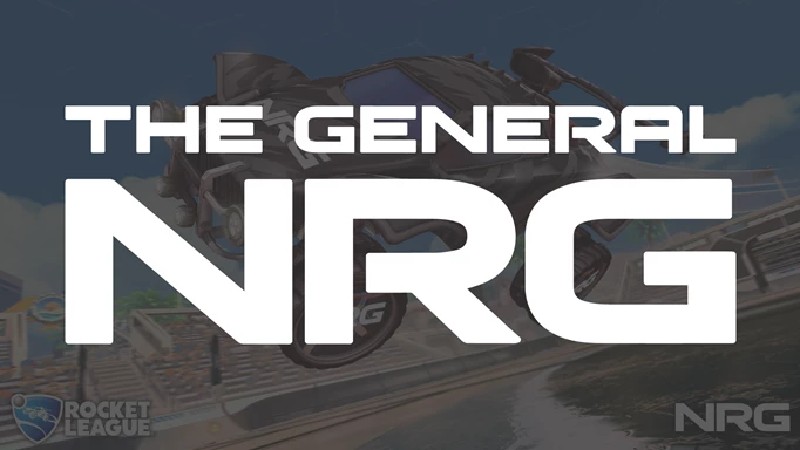The General NRG Rocket League
NRG Esports were founded in 2015 by the Sacramento Kings co-owners Mark Mastrov and Andy Miller, and are currently active in a number of Esport titles such as Apex Legends, Fortnite, Overwatch, Rocket League, and Valorant to name a few. Over the past 7 years they have had respectable success, winning various championships with the bulk of their success coming in Rocket League.
NRG In Rocket League
The pride of North America, NRG Esports first entered Rocket League in 2016, picking up the Kings of Urban roster of Jacob, Fireburner and Sadjunior after RLCS Season 1 in 2016. RLCS Season 2 in Amsterdam saw NRG bow out of the finals after a loss to eventual winners Flipsid3 Tactics, finishing 5-6th. GarrettG was then picked up from Orbit, replacing Sadjunior. This new roster placed 3rd at LA’s RLCS Season 3 World Championship, again losing out to the eventual champions, this time Northern Gaming. Disappointment in a last-place finish in the RLCS Season 4 Finals led to NRG dropping fan-favorite Jacob for rookie and true prodigy of a player in jstn.

With jstn, NRG were one goal away from becoming World Champions in that famous London Grand Final in Season 5. NRG continued as always to dominate RLCS North American regional play in Seasons 6 and 7, only to fall short of expectations at both finals. Fireburner announced he was stepping away from competitive Rocket League, and then it was revealed that three-time RLCS champion Turbopolsa, who played on the Dignitas team that defeated NRG in Season 5, would be his replacement and become the first player to make a cross-region move from Europe to North America.
NRG Esports would immediately go on and win Season 8’s World Championship in Madrid in December 2019, beating Renault Vitality in a seven-game Grand Finals with jstn scoring the winning goal in overtime. They would then replace Turbopolsa with SquishyMuffinz, a fan-favourite player coming from the recently disbanded Cloud9. With this now current roster, they went on to win RLCS X North American Championship, with the team being known as “The General NRG” from the Spring of 2021 as The General acquired the naming rights to the team, and during this time youtuber Musty joined the team as their substitute.
NRG Roster
The longest standing member of the current NRG Roster is Garrett “GarrettG” Gordon, one of the pillars of the Rocket League Esports scene and as of the Winter Major, the only player in history to have attended every RLCS LAN as a player. Now aged 19, jstn is still the youngest of the trio and following making his name in the Rival Series on the Out of Style team, has since spent his career to this point alongside GarrettG and now his friend Squishy also. The Canadian Mariano “SquishyMuffinz” Arruda announced himself on the world stage with the Muffin Men at Dreamhack Atlanta following disappointment with Team Iris. Then was his Cloud9 chapter, including a historic ceiling shot goal at the Season 4 Finals, and winning the Season 6 World Championship to break the Dignitas dynasty. Their coach, former professional player and personality Emiliano “Sizz” Benny joined the team during Season 8 in 2019, and is frequently seen talking to the team and keeping spirits high during tactical time-outs.

NRG Playstyle
NRG’s Playstyle has frequently seen fantastic mechanical play from jstn create holes in opponent defences in order for GarrettG’s strong and consistent shooting to come through. While Squishy is often filling gaps and keeping the rotation strong, all are frequently involved in the offence as seen by the whole team individually contributing to more than one goal per game at the Fall Major. The Team in recent months has apparently been working on a new playstyle and changes in the hope of improving results, so we will have to see how it develops.
NRG In RLCS 2021-22
NRG as always come into the new and current season as North America’s top team and the expectation to live up to that standard. And in the Fall Split they would, podiuming in all three of the regionals, winning the second and thus becoming NA’s #1 seed team for the crowdless Fall Major in Stockholm. There they would struggle in the swiss stage but escape at the final call after a sweep over Oceania’s Ground Zero Gaming, and then take out Sandrock Gaming and FaZe Clan to reach the Grand Finals, before falling to Team BDS.
Winter brought even more domestic success, again being North America’s number 1, but the going wasn’t smooth at the LAN event itself this time. Losses in the group stage to South America’s Furia and Europe’s Endpoint meant NRG started in the Lower Bracket, and there NRG would lose in game 5 against Team Queso for a first round elimination. The questions have only grown at the start of the Spring split after a Top 12 finish in the first Regional, and a recovery only as far as 4th place in the second Regional.














